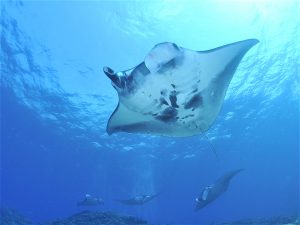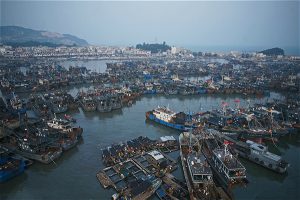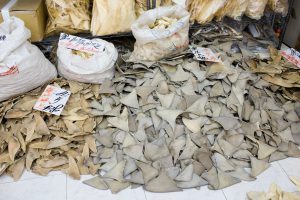In July, water discharged by a hydropower station on the Qing River surged downstream, taking with it almost 10,000 tonnes of sturgeon. The surge blew them out of fish farm cages, and down the Qing, a tributary river, into the middle and lower reaches of the Yangtze.
Experts fear a disaster for native sturgeon, and the Yangtze ecosystem, as the farmed fish are either hybrid sturgeon or non-native species.
According to state run news website The Paper, the number of escaped fish may be greater than that of all surviving native fish populations on the Yangtze combined, and far outstrips the number of Chinese sturgeon remaining in the wild.
Tipping the scales
The new arrivals will compete with native fish for food and territory, putting more pressure on the endangered Chinese sturgeon.
Species of sturgeon native to the Yangzte include the Chinese sturgeon and Dabry’s sturgeon. Both are “red-listed” as endangered by the International Union for the Conservation of Nature (IUCN).
Chinese sturgeon are giant fish, growing to 5 metres long, whose annual 2,000-metre up-river migration from the East China Sea is threatened by dam-building, heavy pollution and injuries from shipping. Dabry’s sturgeon inhabit only in the middle and upper Yangtze. Once plentiful, their population plummeted in the 1980s, and they were listed as critically endangered in 1996.
If the hybrid escapees interbreed with pure-bred Chinese or Dabry’s sturgeon then these threatened species will become even rarer.
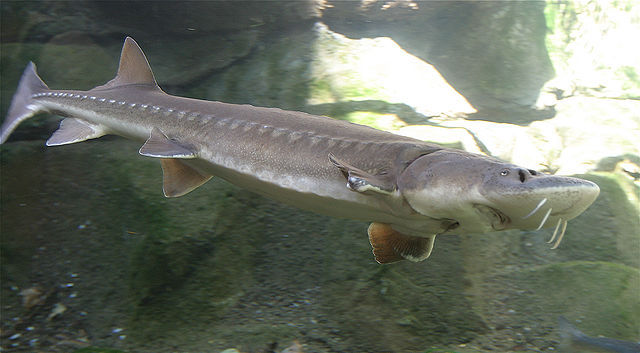
A Chinese sturgeon. Image by Cacophony
Glimmer of hope
Yang Yuanjin, deputy director of the Chinese Sturgeon Research Centre, told chinadialogue: “The fortunate thing is that the escaped fish have only spread downstream. If this had happened on the Jinsha River further upstream, the situation would be even worse.”
Yang explained: “The Chinese sturgeon breeds during autumn, while hybrid sturgeon breed in the spring – so there’s little chance of interbreeding. But the Dabry’s sturgeon on the Jinsha also breeds in the spring, so if this had happened on the Jinsha there’d be a huge risk of genetic contamination from interbreeding.”
Poorly regulated
Cage farming of hybrid sturgeon has been expanding since the 1990s. Yang said regulation is failing to keep up, so risks to the Yangtze ecosystem from non-native species are increasing.
Cage farmers raise fish in mesh enclosures placed in a natural body of water – usually water that is flowing, clean and oxygenated.
Yang thinks better regulation of fish farms is crucial: “Currently there are no rules on the purity of fish farm stock, or on the types of feed used. Fish farmers add antibiotics to the fish feed to accelerate growth – but this also pollutes the river.”
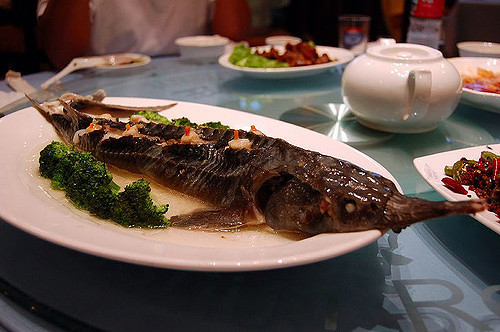
Cage sturgeons serve at restaurants. (Image by ulterior epicure)
Lack of information
Meanwhile, discharges of water from the numerous hydropower stations on the Yangtze basin during flood season can easily result in farmed fish escaping into the river.
Asked why fish farmers are not warned of in advance of discharges, Zhang Boting, deputy secretary of the China Society for Hydropower Engineering, told chinadialogue that fish farmers must assess the risks themselves.
Villagers were catching hybrid sturgeons on the Yangtze as early as July and August this year, but not in large enough numbers to arouse concern.
Zhu Jiang, director of WWF China’s Yangtze project, told chinadialogue that previously farmed fish (including sturgeon) have escaped from fish farm ponds or cages in reservoirs during the flood season and then made their way into natural waterways such as the Yangtze. In July this year thousands of fish gathered underneath a dam on the Han River in Hebei province, an event which was linked to large escapes of farmed fish into the river.
But this escape of non-native sturgeon is far bigger than anything before.
Big problem
“There are many issues in conservation of the original Yangtze species, including others besides the sturgeon,” Zhu said. “And China lacks effective policy or measures for protecting those species.”
Wei Qiwei, director of the Ministry of Agriculture’s Key State Laboratory for Conservation of Freshwater Biodiversity, told chinadialogue that the current remedy is to catch the escaped fish as soon as possible.
But according to The Paper, the escaped sturgeon will eventually spread upstream as well as downstream, devastating the entire basin and making recapture harder. The Yangtze River Office at the Ministry of Agriculture has arranged for experts in aquatic life to investigate the incident and assess the ecological impact.


